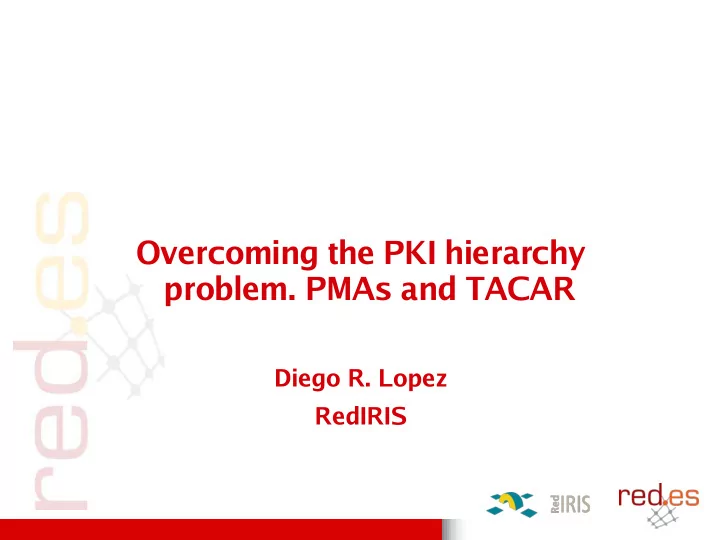

Overcoming the PKI hierarchy problem. PMAs and TACAR Diego R. Lopez RedIRIS
PKIs and their growth problems The original X509 concept implicitly asumed a common global root for certificates At least, so it was perceived in many cases Similar to the old X500 idea of a single global root for The Directory This (as with the case of LDAP) has proven unfeasible This implies the need of concialiating several roots of trust Traditional solutions to this problem Building a mesh of cross-certificates Extending hierarchies to a common (agreed) root The first one does not scale The second imply policy problems New solutions applied/explored in the academic arena PMAs and trust repositories Bridges PMAs and TACAR
Hierarchy problems A common root is not feasible even in the "simpler" academic world Policies have incompatible purposes and even basic principles Not even mentioning national regulations Several applications impose limitations in the certificate verification procedues Most notably, currently used Grid software Extending the infrastructures usually means cumbersome resigning processes Scaling problems become even worse than in the mesh case PMAs and TACAR
PMAs and TACAR The simpler, the better Keep the solution as simple as possible Take advantage of the already existing trust links in the community Explore and extend the technologies Seek for support in the EU and beyond Endorsment of the EUGridPMA and TACAR by the eIRG as a "first step towards common EU policies for authentication for resource access and sharing for e-science" International Grid Trust Federation The Cotswolds Group PMAs and TACAR
PMAs Policy Management Authority Defines a set of minimal requirements and good practices It accredits PKIs Authentication and key management procedures Signing policies By means of a peer review process Several active PMAs Basically related to Grid infrastructures Europe, America, Asia-Pacific http://www.eugridpma.org/ A federation of these PMAs has been established The International Grid Trust Federation http://www.gridpma.org/ PMAs and TACAR
More on PMAs Participants Accredited PKIs User infrastructures where the accreditation is accepted Trust repositories The PMA does not provide identity assertions But guarantees that certificates comply to the minimal requirements Verifiable through the trust repositories Accoding to the limits established by its policy All accredited PKIs are to be considered equivalent As authentication providers Authorization is performed by the relaying party PMAs and TACAR
A case study: The EUGridPMA Formally established in April 2004 http://www.eugridpma.org/ Participants from Europe and beyond A single PKI per country (whenever possible) Relaying parties are national and trans-national Grids EGEE, DEISA, LCG, SEE-GRID,... Identity is only applicable to e-science environments Encryption and digital signature are not supported The participants are not to be considered digital signature agencies according to the EU directives Financial transactions are not supported It is required to comply to GSI technical requirements TACAR is used as trust repository PMAs and TACAR
The EUGridPMA coverage Other participant PKIs: CERN Catch-all for EGEE, LCG, SEE-GRID Russia (LCG) Israel Armenia DoEGrids (USA) FNAL Service CA (USA) Canada Japan Taiwan Pakistan PMAs and TACAR
TACAR. The goals Provide a means for building a PKI-based web of trust Among the European academic community (and beyond!) Without the technical and administrative overhead of a root or bridge CA Based on two basic principles Keep it simple Let it happen Initially conceived as a collection of certificates More formalization was rapidly requested and incorporated PMAs and TACAR
TACAR. The two basic principles Keep it simple Do not require extra developments Make the whole system sustainable Let it happen Follow a very pragmatic approach Gain critical mass Act according to user organization demands The better illustration is the original evolution TACAR was conceived as a simple PKCS#7 distributed via TLS Policy issues came into play and the TACAR policy was created PMAs and TACAR
The TACAR Policy – I Which PKIs can be included Directly managed by TERENA members: NRENs (Inter)national academic infrastructures: EUNIS, Educause, Internet2,... Non-for-profit research projects directly involving the academic community: Grids Including a PKI Self-signed certificate(s) Policy documents (CP/CPS) and fingerprints Face-to-face meeting to build the initial trust links The policy document includes sample letters for Registration Collected by the TERENA officers when incorporating a new CA Accreditation (optional) Aimed to simplify interactions (electronic updates) PMAs and TACAR
The TACAR Policy – II Updating the information pertaining a PKI Mandatory in case of any change Certificates or policies Only allowed for accredited people Face-to-face By e-mail, using PGP Measures for repository maintenance Available through a secured web page Periodic checking of data accuracy Procedures for changing the policy itself Agreement among the participating organizations PMAs and TACAR
Current status An updated policy Some clarifications requested by new members Explicit mention to the site certificate and its diffusion Explicit mention to the site security measures Has exercised the policy update procedures Twenty certificates currently available Everything at http://www.tacar.org/ SSL access through a self-signed certificate https://www.tacar.org/ DN: dc=org, dc=tacar, cn=www.tacar.org Fingerprint: 10:AE:CE:44:A2:CC:15:C7:1D:71:61:6B:B5:70:AD:5C PMAs and TACAR
What is TACAR providing A trusted source for Root certificates Policies The repository is built and updated by means of out-of-band methods Face-to-face meetings Required for the initial incorporation PGP-enabled mail (Optional) bundles of available certificates A platform to experiment with Lighter than a common root, simpler than a bridge PMAs and TACAR
New proposals around TACAR A mechanism for extending trust links By means of semi-cross certificates Included by each participating PKI as another certificate in its hierarchy TACAR as the root verification point for issuing and renewing the semi-cross certificates A certificate verification service Based on OCSP TACAR as trusted source for certificates and CRLs,simplifying maintenance procedures A certificate diffusion system Derived from e-mail addresses and DNS, mostly oriented to encryption and digital signatures TACAR as the common trust root PMAs and TACAR
Recommend
More recommend